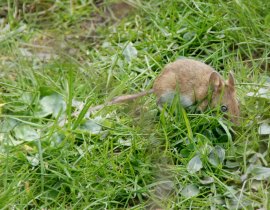Professional Pest Control & Wildlife Management
Wood/Field Mouse
Woodmice Apodemus sylvaticus are a very common problem in peoples homes and lofts. Like its cousin the House mouse it can gain access through the smallest of gaps and needs to gnaw to keep its teeth down.
Woodmice are distiguished from House mice by their size (upto 25gms), their ears and eyes are proportionally larger too. The coat of the Wood mouse is a dusty light brown with a white underside. Woodmice have long hind legs and tend to jump as much as they run, when heard at night this they are commonly misconcieved as something larger (noises always sound louder at night).
-
Risks
Like the House mouse, Woodmice are incontient and will pee and poo wherever they go. Their droppings tend to be slightly larger and noticably rounder than house mice. They too carry lots of illnesses and diseases, but most importantly is their need to gnaw. Their teeth are constantly growing and to prevent them from growing right through the top of their jaws they must chew, which is aproblem when they are in a loft with wires available.
Its reported that 15% of domestic house fires are attrinuted to rodent damaged wiring.
-
Treatment
Field or Wood mice are treated in the same way as the house mouse, with either traps or rodenticides after an initial survey.
Treatments usually consist of a minimum of three visits, the initial will begin with a survey after which the technician will discuss their findings at what options are available. The second visit will typically be within ten days of the first. On the second visit it is often possible to identify a mouse infestation as being wood mice if they have attempted cache the bait - a natural behaviour for woodmice to store food for later. They will quite literally pick up anything they can lift including stones, coins, plastic soliders and cover up any bait they cannot eat or carry off, often insulation will be scrapped up and dragged over (see photo).
Woodmice are not shy of bait and usually take it up the same evening it has been laid. The purpose of the second visit is to refresh the baits so when we return for our last visit we can inspect the baits to ensure no further activity has occured.
-
Life Cycle
Female Wood mice are exceptional breeders. They can knock out upto ten young after a gestation period of just over three weeks and can then become pregnant again almost immediately. The young mice are dependant upon mum for three weeks, and then at two months they themselves will be adding to the population.
- False Widow Spider Removal
- Cluster Fly help
- The trouble with fleas?
- Mole Catching in Suffolk
- Rats in the Garden
- Wasp Nest Control
- Rats in your chicken Coop
- Anaphylaxis
- Bee Swarms
- Becoming a Beekeeper
- Rare Breed Poultry
- Pest Control with Birds of Prey
- Un-marked vehicles available
- Rabbiting with Ferrets
- Myxomatosis
- Poll-Tex Mesh
- Honorary Member Russell Wallis
- Free Rabbit Control


